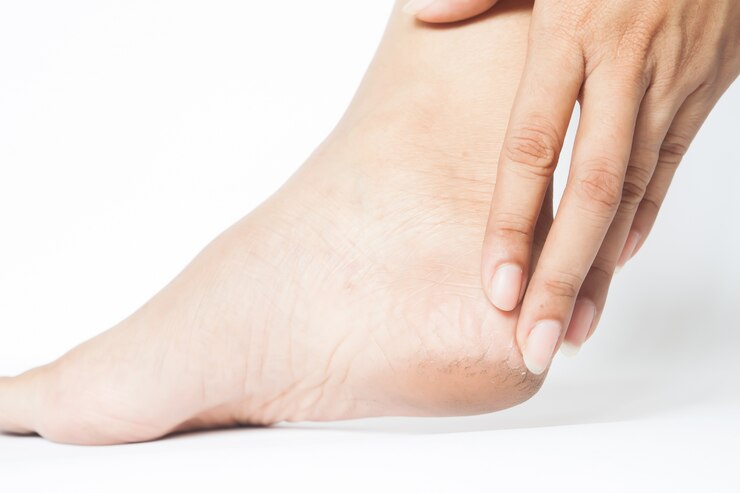Cracked heels are not just unappealing, but they can be painful. Many individuals struggle with this issue; if you are one, I’ll list ways to heal cracked heels permanently.
We pay more attention to our hair, skin, and nails. However, there’s a part of our body that often gets overlooked—heels! In this article, I will discuss the top seven tips to achieve smooth and healthy heels.
Dry, thickened skin on the heels causes cracked heels, resulting in fissures or deep cracks. Below are some of the reasons your heels are rough.
Causes of Cracked Heels
i. Dry skin
One of the leading causes of a cracked heel is dry skin. The feet, just like any other part of the body, can suffer from dehydration. Dry air, harsh soaps, and long, hot showers can all strip our skin of its natural oils, leaving it looking cracked and rough.
ii. Lack of moisture
Another factor is lack of moisture. When the skin on our feet doesn’t receive proper hydration, it becomes less elastic and more prone to cracking.
Conditions like eczema and psoriasis can also contribute to this issue, as they further compromise the skin’s ability to retain moisture.
iii. Improper footwear
Wearing improper footwear is yet another key player in the cracked heels dilemma. Open-back shoes or sandals can cause our heels to constantly rub against hard surfaces, which eventually leads to calluses and cracks.
In addition, standing for long periods or being overweight can put excess pressure on our feet, making them more susceptible to cracks.
iv. Nutritional Deficiencies
Inadequate intake of essential vitamins, particularly A, E, and C, can contribute to dryness and impaired skin healing. Vitamin deficiency affects the overall health of the skin, making it more susceptible to cracks and other wounds.
How To Heal Cracked Heals Permanently
If you’re wondering, “What is the fastest way to heal cracked heels?” or “How do you permanently get rid of cracked heels?” You’re in the right place. Here are some quick ways to repair a cracked heel:
- Keep your feet clean and moisturized
- Exfoliate regularly to remove dead skin
- Wear proper footwear
- Use essential oils
- Incorporate a healthy diet
- Soak Your Feet in Epsom Salt
- Consult a podiatrist
1. Keep your feet clean and moisturized
First, maintaining proper hygiene is vital for healing cracked heels. Regularly wash your feet with warm water and mild soap, ensuring to gently scrub away any dirt or dead skin.
After washing, thoroughly dry your feet, especially between the toes, as moisture can lead to fungal infections. Once your feet are clean and dry, apply a rich moisturizer or foot cream, generously massaging it into your heels and the surrounding areas.
2. Exfoliate regularly to remove dead skin
Exfoliating your feet regularly helps remove dead skin cells, allowing healthy skin to surface. To exfoliate, soak your feet in warm water for about 15 minutes, then gently scrub them with a pumice stone or foot scrubber.
This process will remove the thick, dry skin that contributes to cracked heels. Remember to pat your feet dry afterward and moisturize them to lock in moisture.
3. Wear proper footwear
Choosing appropriate footwear is essential to preventing cracked heels. Go for shoes that provide adequate support and cushioning for your feet.
Open-back or ill-fitting shoes can increase the chances of developing cracked heels, as they put excess pressure on your heels. Moreover, wear socks made of breathable materials to wick away moisture and keep your feet dry throughout the day.
4. Use essential oils
Certain essential oils have healing properties that can help in the treatment of cracked heels. Tea tree oil, for instance, possesses antimicrobial properties that combat fungal infections and promote skin healing.
Lavender oil, on the other hand, has soothing and moisturizing effects that aid in rejuvenating dry and cracked skin. Dilute a few drops of your preferred essential oil with a carrier oil, such as coconut or olive oil, and apply the mixture to your cracked heels before bedtime.
5. Incorporate a healthy diet
Include foods rich in vitamins A, C, E, and omega-3 fatty acids in your diet to promote skin health. These nutrients help improve skin elasticity, boost collagen production, and enhance wound healing.
Foods such as carrots, broccoli, oranges, nuts, and fatty fish are excellent choices to maintain healthy and crack-free heels.
6. Soak Your Feet in Epsom Salt
Epsom salt is renowned for its therapeutic properties and can work wonders on cracked heels. Dissolve half a cup of Epsom salt in warm water and soak your feet for approximately 15–20 minutes.
The salt helps soften your skin, making it easier to remove dead skin cells during exfoliation. Additionally, the magnesium sulfate present in Epsom salt aids in reducing inflammation and soothing the pain associated with cracked heels.
7. Consult a podiatrist
In severe cases where home remedies do not provide relief, consult a podiatrist or a foot specialist. They can prescribe appropriate medications or suggest advanced treatments to heal your cracked heels permanently.
Professional intervention may be required if you experience excessive pain, or bleeding, or if your cracked heels become infected.
Natural home remedy for dry, cracked heels
a|) The use of bananas
One of the most effective and natural remedies for dry and cracked heels is banana. Simply mash up a ripe banana and apply it to your cracked heels. Leave it on for about twenty minutes, and then rinse it off with lukewarm water.
The banana’s natural oils will penetrate your skin, moisturizing and nourishing it in the process. If you follow this routine regularly, you’ll notice an improvement in the condition of your heels.
b) Honey and olive oil
Another home remedy that’s worth trying is the classic duo of honey and olive oil. Blend one teaspoon of honey and two tablespoons of olive oil to create a thick paste.
Apply this mixture to your heels and cover them with socks to allow the magic to work overnight. The honey will act as a natural humectant, drawing moisture into your skin, while the olive oil will provide deep hydration.
Rinse off the mixture in the morning, and give your feet a quick scrub with a pumice stone.
c) Petroleum jelly
If you’re dealing with mild to moderate cracks, apply petroleum jelly to your feet; this helps lock in moisture and prevent further drying. Wear socks after applying the petroleum jelly to enhance its effectiveness and accelerate the healing process.
Conclusion
Cracked heels can be effectively treated and prevented through proper care and attention. Fundamental to this is maintaining proper foot hygiene.
Follow essential foot care practices, such as regular washing, drying, and the consistent application of moisturizers. These steps help ensure healthier, crack-free feet.

